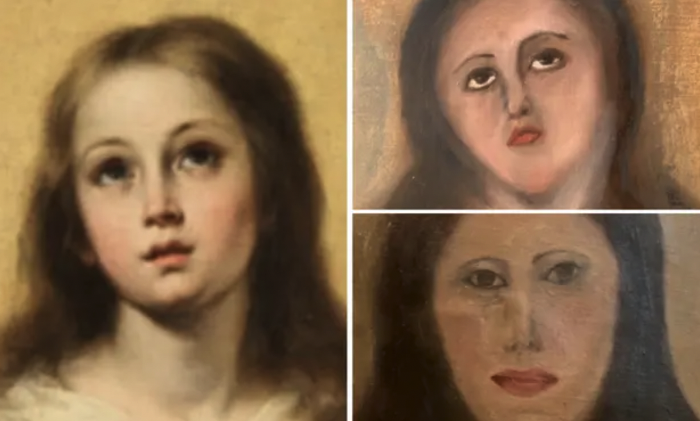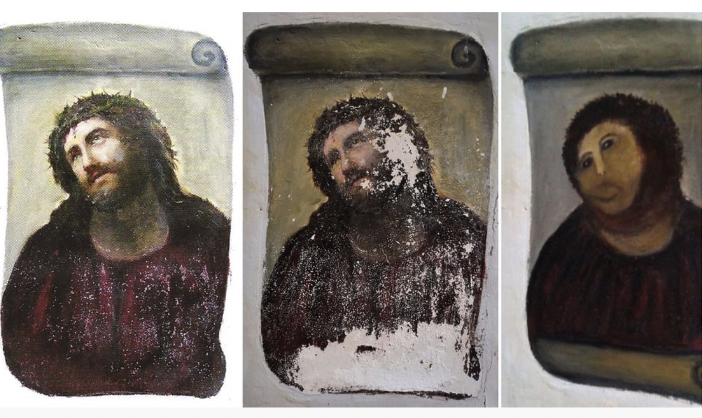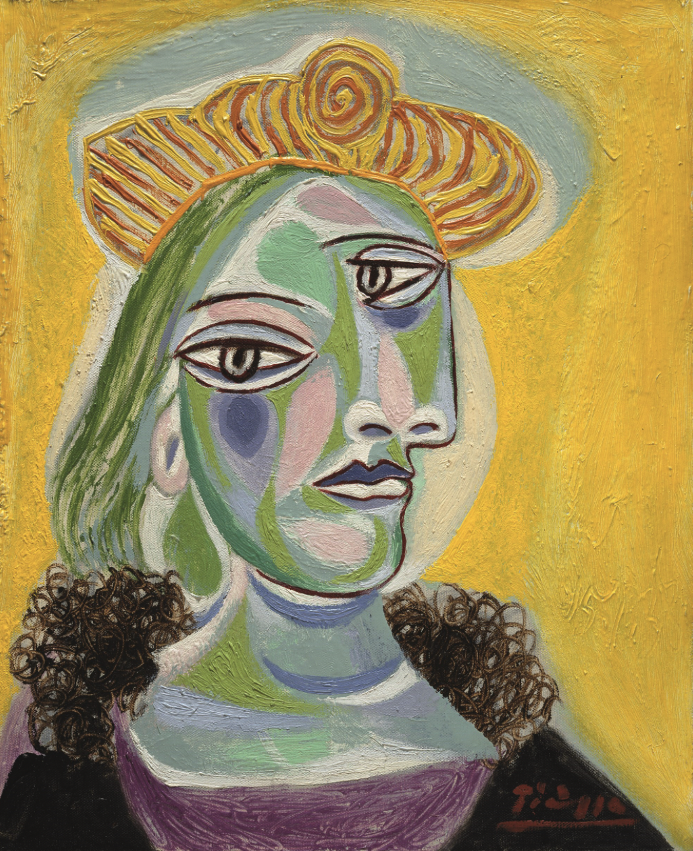Spain has made another bid for top spot in the hotly contested international league table of cultural vandalism, this time with an amateur statue re-carving reminiscent of Mr Potato Head.
The statue, on the façade of a high-street bank in the Spanish city of Palencia, was ‘repaired’ by an amateur after the head fell off. The substitute head was first noticed by local painter Antonio Capel, who published the find in a Facebook post, and joins a long list of destructive ‘restorations’ in the country.
Earlier this year, a copy of Murillo’s Virgin Mary was so badly ‘restored’ it was sent for a second attempt, only to end up even more irreparably ruined.

And the most famous of all was the 2012 ‘restoration’ of an Elias Garcia Martinez fresco in Borja, dubbed ‘Monkey Christ’ which was so monstrous it triggered a rash of Monkey Christ Halloween costumes.

At a practical level, these botched restorations may simply be a byproduct of the fact that to study fine art in contemporary terms in no way implies any training in the skills once considered essential to fine art.
Michelangelo’s students spent years imitating the work of the master, or copying sculptures from the ancient world, before being let loose to try and realise their own vision. In contrast, contemporary artists commonly exist in a tortured relation to the past: at once pinned in relation to art history but duty-bound by contemporary neophilia to reject the canon in search of ‘originality’.









Join the discussion
Join like minded readers that support our journalism by becoming a paid subscriber
To join the discussion in the comments, become a paid subscriber.
Join like minded readers that support our journalism, read unlimited articles and enjoy other subscriber-only benefits.
SubscribeIn Britain (if not in other parts of the world) there has long been a kind creative snobbery at work. A distinction is drawn between:
“The Artist” ““ a high-minded fellow brimming over with creative spirit and an originality that his small-minded contemporaries just cannot understand.
“The Craftsman” ““ a skilled fellow who produces popular, good looking work but lacks the world-shaking vision that the true art-lover requires. In fact, the popular appeal of his work is taken as a sign of its artistic inferiority.
The Artist must be careful not to be seen to be taking too great an interest in technique lest he be suspected of being a closet Craftsman and suffer a consequent loss of status.
I find this to be a strange reply to an article about inept restorations IN SPAIN.*
*Not in Britain for those at the back.
I find your reply to my comment to be strangely rigid!
As I live in Britain I thought it worth mentioning the attitude to art versus craft I have often encountered here. I also added a note in brackets suggesting this attitude may also be found elsewhere in the world.
Mary Harrington herself widened the discussion out to a more general look at prevailing attitudes to artistic skill ““ refer to this paragraph:
“Because originality matters more than artistic skill, many fine art students today can’t draw, paint or sculpt and don’t consider this in any way an impediment to their artistic practice. If this condition permeates throughout European art schools, it’s perhaps unsurprising that even those who aspire to make (or restore) beautiful things lack the skill.”
That’s “…many fine art students today…”
and NOT:
“…many SPANISH fine art students today…”
I also refer you to her final paragraph where she talks about the wider implications for Western art. This discussion is about more than just “inept Spanish restorations”. These are, if I read Harrington correctly, symptomatic of a wider problem.
You seem to have missed the point of the article. I get the impression that you read the headline looked at the pictures, skimmed the piece and reached for the keyboard.
By the way, I hope you are aware that Picasso had a major influence on Western art outside of Spain.
A very thought provoking and disturbing piece that echoes some of my own thoughts about contemporary art and architecture.
To be fair, I see quite a lot of what I consider to be quite good/interesting art in the private galleries I visit on a regular basis. Some of this work seems to involve a high degree of artistic skill. (I was described by the drawing teacher as probably the worst ‘drawer’ ever to pass through an English Art Department so I am not really qualified to make a judgement in that sense).
Even so, It often occurs to me, particularly when recoiling in disgust from most public sculpture and almost every new building, that there is simply no way back to any form of grace or harmony.
There may be a way back, on the level of individual artworks and buildings. But the trouble with architecture in particular is that there’s no way back to the coherence (coherence in variety, let us say) which characterised our cities a mere century ago, when literally nothing ugly had ever been built! As late as the age of Art Nouveau, perhaps even in the era of Art Deco, the new literally built on the old: consider the seamless way in which Jugendstil buildings are integrated into a medieval ensemble in Vienna or Prague. And then, by contrast, reflect on the ghastly obtrusive stuff flung up in so many European cities after World War II. There would be no way to rectify the situation but by tearing down whole quarters of many cities and rebuilding in historical facsimile! I can’t see that ever happening.
I have identified, at last, the word your machines objected to.
Really, your moderation machines pick on some strangely innocent words…
Please recalibrate your moderation machinery; it is stigmatising quite innocent language.
The extreme ugliness of modernism underlies the corruption of the twentieth century, for it expresses the view that humanity can and must be “transformed”, the characteristic aim of communist regimes. Hence the determination to shift the ear from melody; to junk perspective and anatomy in art; plot and character in novels and so on. Only now are the modernists making their final bid for power and nothing seems to stand in their way. They seek to manipulate minds, just as Orwell’s party does in 84, rejecting the very existence of reality as their starting point. Once this has been effected in any human mind; once truth has been dethroned, corruption runs riot and any transgression is made possible. Orwell’s O’Brien runs a torture chamber, you will recall. Dark, dark times
We shouldn’t forget that most of the mediocre artists of the past have been forgotten. We now look at the cream of the cream.
As regards buildings, it’s a bit much to say that nothing ugly was ever built before the 20th century. But before reinforced concrete and steel structures, architects were more constrained by the limitations of their building blocks. And going back in time, as someone else already commented, there was an understanding of proportion that seems to have been lost.
“nothing ugly had ever been built” Really?
As you know Basil, beauty is subjective, but would you defend either Westminster Cathedral 1903/10, or Sacre-Coeur de Montmartre, 1914/19 for example?
In my eye they are both abominations.
Lay off Picasso who had the finest of C19th classical art training and whose every work was informed by that training. That to the untutored eye there is any correlation with these monstrosities is a damning reflection on the lack of discrimination now applied the fine arts. You can’t really paint ‘badly’ well, unless you have first learnt to paint well.
The cubist Picasso had a point to make. It wasn’t nonsensical. It represented multiple points of view within the same image, posing the questions being contemplated by philosophers of the time including his friend Sarte. Namely whether there was any one concrete reality and one perspective, or whether everything was a varying but valid reality based on any particular perspective. His idea was to imagine that if this were so, what the actual reality must look like if it could be viewed as a whole fro9m all perspectives.
Of course Picasso did the Picasso thing and 100% cheapened his own work by over producing and knocking out inferior reiterations of his own work, generally of a declining technical skill.
He was a money grubber no doubt. He put out +140,000 pieces in his 91 years, that is about 4.5 pieces a day starting the day he was born. Much of it had to be junk.
Thanks for this. If they lack an understanding of their own traditional culture and religion and of the history of their country – as well as lacking artistic ability – this is what you get.
There’s a real resistance to the importance of mathematics in high art. Creating proportion, symmetry and harmony requires an understanding of geometry, something sadly lacking in today’s art schools.
Perhaps the arts and sciences have become too distinct, when our greatest thinkers have had a foot in both — think of Da Vinci’s understanding of the human body, or Einstein imagining whizzing around the universe on a beam of light.
There are parallels here with resistance to science in modern conceptions of gender, particularly the idea that it is all a ‘social construct’ and has nothing to do with biology. A concerning disregard for any rule or boundary.
You have to be fair to the Mr. Potato Head sculptor. They probably intended the replacement to not look like the original, but to be obviously a late addition, the clue being in the third eye for a mouth. Since the head fell off, rather than degraded, this is probably an odd decision, but not in the same league as the Monkey Christ
All is not lost. Two words. Sandy Stoddart.
It’s not our way of seeing – it’s mere incompetence !
As another commentator has noted ,Picasso was in fact skilled in traditional western draftsmanship, his personal quest for a unique style led, via investigations of indigenous works from other continents, to an over-rationalised aesthetic that pertains now in all western arts from architecture to music, To conflate this theoretical dead-end with ordinary technical ineptitude as the last paragraph of the article does,is to demonstrate the essence of the critical misunderstanding that pervades the dominant culture and precludes any progress out of our present sad situation.
Picasso did not commercialise art, he held no commericial exhibitions until Kahnweiler developed the Galerie Leiris as avehicle for Picasso in the late 50s.
He was an artist who led by example and collaboration. He was endlessly pursued by people wishing to make money from his work. His whole life was work, his output a credit to his industry, he was dtermined to endlessly innovate which was disliked and distrusted by the art world which needed to catagorise and label, in order to calibrate value. Picasso was Modernist, now a much abused term but which was simply a desire to build on art history traditions to develop new ways of vision to reflect and enlighten new realities.
What a fearful proposition! That contemporary artists have been trained so badly that it will be almost impossible to duplicate the skill and thus restore the works of artistic masters that will inevitably suffer the degradations of time is too awful to think.
There are some good sensible comments here but as an artist I believe a key problem are the art course tutors and media obsessed critics. Tutors are of the poorest quality and I have never met an artist that said they learnt their craft in a college environment. Lazy and useless is the norm. Fine art college courses is for students looking for the easiest excuse to do as little as possible.
Most who opt out to pursue a career in art start after they leave.
Critics and ‘experts’ on art are good at mumbling the endless stream of gobbledegook. Making nonsensical claims about the artist and work they are studying. I have yet to meet an ‘expert’ who actually knew the subject.
No one can tell you what is good or bad art. Long ‘meaningful’ explanations are instant put off’s, what the work ‘means’ and what ‘it’ means are the norm for rubbish.
It the viewer who is the expert. “Do you like it?” or “would you buy it” are the only criteria for a working artist.
So called contemporary art (what does that mean?) scoffs at drawing. Yet this is the fundamental skill of an artist. Copying is an other key skill, if you can copy a master then you have the talent to develop. Perhaps the only art work I suspect was not copied were cave paintings. Could be wrong of course. Also galleries play a role in allowing c**k eyed garbage to be presented as cutting edge etc. Some people buy it???? If you can look and admire a work of art for itself without a plethora of ‘experts’ bending your ear I would be happy. An artist’s life is tough and may not be rich in cash but produce what you feel is a quality piece and you’ll sleep with a smile on your face.
It is nothing less than headlong cultural decline, now that the poisonous pretences of modernism have seeped into wider society. Picasso knowingly destroyed art; incompetent charlatans like Matisse just jumped on the bandwagon and envy, (which always hates talent, even when it rejoices, like the rest of us, in its products), has gleefully supported the obliteration of the beauty, skill and honest judgement which put it in its place. We have tolerated the relativism which permitted sheer nonsense for far too long; and it would take decades of renewed training to reverse this decay.
Oh dear. Picasso and Matisse were both modernists. They both had excellent classical training and used that training to expand the world of art from the dreary realism amd sentimentality of C19th art. Modernism had run it’s course by 1939. What you complain of is ‘Post-Modernism’ a child of the 1960’s with it’s b*****d children ‘Conceptual Art’, ‘Performance Art’ etc, where indeed relativism reigns supreme and anyone can be an artist.
Picasso didn’t destroy art. He commercialized the evolution of art out of its old representational roots. It was photography that made that representational art redundant. Picasso just prostituted the change.
Photography no more made representational art redundant than TV replaced theatre. The experiences are so distinct that one cannot replace the other. As for the vile Spanish fraud, he certainly coasted along on this implausible excuse, along with a host of persons anxious to derail and destabilise “bourgeois” society. The traitor Blunt admitted that so-called “abstraction” was invalid in the workers’ paradise – exposing the communist agency behind “modernism”.